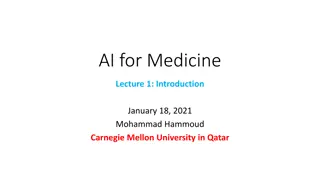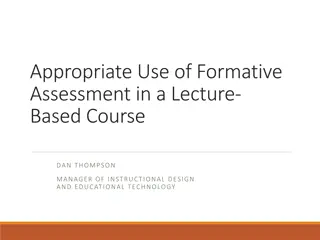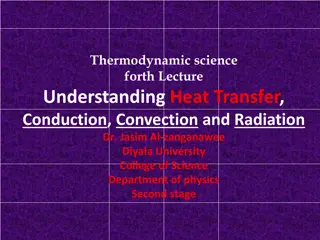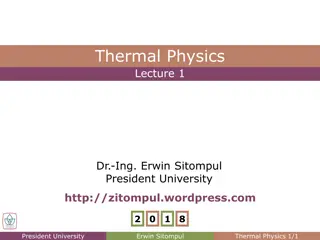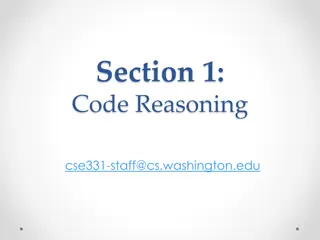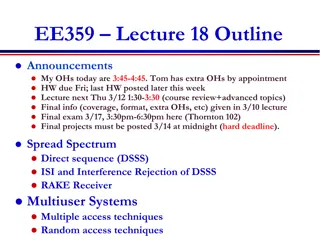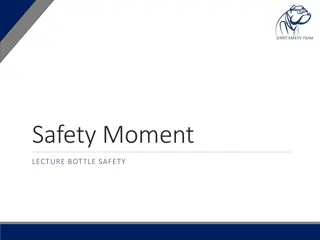
Understanding Huffman Codes for Data Compression
Explore the concept of Huffman Codes in data compression, learn about prefix codes, binary character codes, and the greedy algorithms used for optimal compression. Discover the top-down and bottom-up approaches, and see how to create efficient prefix trees for encoding data.
Download Presentation

Please find below an Image/Link to download the presentation.
The content on the website is provided AS IS for your information and personal use only. It may not be sold, licensed, or shared on other websites without obtaining consent from the author. If you encounter any issues during the download, it is possible that the publisher has removed the file from their server.
You are allowed to download the files provided on this website for personal or commercial use, subject to the condition that they are used lawfully. All files are the property of their respective owners.
The content on the website is provided AS IS for your information and personal use only. It may not be sold, licensed, or shared on other websites without obtaining consent from the author.
E N D
Presentation Transcript
CSE 421 Greedy: Huffman Codes Yin Tat Lee 1
Compression Example 100k file, 6 letter alphabet: a 45% b 13% c 12% d 16% e 9% f 5% File Size: ASCII, 8 bits/char: 800kbits 23> 6; 3 bits/char: 300kbits Why? Storage, transmission 2
a 45% b 13% c 12% d 16% e 9% f 5% Compression Example 100k file, 6 letter alphabet: File Size: ASCII, 8 bits/char: 800kbits 23 > 6; 3 bits/char: 300kbits better: 2.52 bits/char 74%*2 +26%*4: 252kbits Optimal? E.g.: a b d c e f Why not: 00 01 10 110 1101 1110 00 01 10 1100 1101 1110 1101110 = cf or ec? 3
Data Compression Binary character code ( code ) each k-bit source string maps to unique code word (e.g. k=8) compression alg: concatenate code words for successive k-bit characters of source Fixed/variable length codes all code words equal length? Prefix codes no code word is prefix of another (unique decoding) 4
a 45% b 13% c 12% d 16% e 9% f 5% Prefix Codes = Trees 100 100 0 1 0 1 55 a:45 86 14 0 1 0 1 0 25 30 58 28 14 0 1 0 1 0 1 0 1 0 1 14 c:12 b:13 d:16 a:45 b:13 c:12 d:16 e:9 f:5 0 1 f:5 e:9 1 0 1 0 0 0 0 0 1 f a b 1 1 0 0 0 1 0 1 f a b 5
a 45% b 13% c 12% d 16% e 9% f 5% Greedy Idea #1 Put most frequent under root, then recurse 100 . a:45 . . . . 6
a 45% b 13% c 12% d 16% e 9% f 5% Greedy Idea #1 Top down: Put most frequent under root, then recurse 100 Too greedy: unbalanced tree .45*1 + .16*2 + .13*3 = 2.34 not too bad, but imagine if all freqs were ~1/6: (1+2+3+4+5+5)/6=3.33 a:45 55 d:16 29 . . . b:13 7
a 45% b 13% c 12% d 16% e 9% f 5% Greedy Idea #2 Top down: Divide letters into 2 groups, with ~50% weight in each; recurse (Shannon-Fano code) 100 50 50 Again, not terrible 2*.5+3*.5 = 2.5 a:45 f:5 25 25 But this tree can easily be improved! (How?) b:13 c:12 d:16 e:9 8
a 45% b 13% c 12% d 16% e 9% f 5% Greedy idea #3 Bottom up: Group least frequent letters near bottom 100 . . . . . . 25 14 c:12 b:13 f:5 e:9 9
14 f:5 c:12 b:13 d:16 a:45 c:12 b:13 d:16 a:45 e:9 0 1 f:5 e:9 (a) (b) 14 d:16 25 25 30 a:45 a:45 0 1 0 0 1 1 0 1 14 f:5 c:12 b:13 c:12 b:13 d:16 1 e:9 0 f:5 e:9 (c) (d) 100 55 a:45 0 1 0 1 25 30 55 a:45 0 1 0 1 0 1 14 c:12 b:13 d:16 1 25 30 0 0 1 0 1 f:5 e:9 14 c:12 b:13 d:16 1 0 (e) (f) f:5 e:9 10 .45*1 + .41*3 + .14*4 = 2.24 bits per char
Huffmans Algorithm (1952) Algorithm: insert each letter into priority queue by freq while queue length > 1 do remove smallest 2; call them x, y make new node z from them, with f(z) = f(x) + f(y) insert z into queue Analysis: O(n log n) T = Tree C = alphabet (leaves) Goal: Minimize ???? ? = ?freq ? depth(?) Correctness: ??? 11
100 Correctness Strategy 50 50 a:45 f:5 25 25 b:13 c:12 d:16 e:9 Optimal solution may not be unique, so cannot prove that greedy gives the only possible answer. Instead, show greedy s solution is as good as any. How: an exchange argument Identify inversions: node-pairs whose swap improves tree 13
Defn: A pair of leaves x,y is an inversion if depth(x) depth(y) and freq(x) freq(y) y x Claim: If we flip an inversion, cost never increases. Why? All other things being equal, better to give more frequent letter the shorter code. before after ? ? ? ? + ? ? ? ? ? ? ? ? + ? ? ? ? = ? ? ? ? ? ? ? ? 0 I.e., non-negative cost savings. 14
100 General Inversions 50 50 a:45 f:5 25 25 b:13 c:12 d:16 e:9 Define the frequency of an internal node to be the sum of the frequencies of the leaves in that subtree. We can generalize the defn of inversion for any pair of nodes. the associated claim still holds: exchanging an inverted pair of nodes (& associated subtrees) cannot raise the cost of a tree. Proof: Same. 15
100 Correctness Strategy 50 50 a:45 f:5 25 25 b:13 c:12 d:16 e:9 Lemma: Any prefix code tree ? can be converted to a huffman tree ? via inversion-exchanges Corollary: Huffman tree is optimal. Proof: Apply the above lemma to any optimal tree ? = ?1. The lemma only exchanges inversions, which never increase cost. So, ???? ?1 ???? ?2 ???? ?4 ????(?). 13
H: 14 f:5 c:12 b:13 d:16 a:45 c:12 b:13 d:16 a:45 e:9 f:5 e:9 (a) (b) 14 d:16 25 25 30 a:45 a:45 14 f:5 c:12 b:13 c:12 b:13 d:16 e:9 f:5 e:9 (c) (d) 100 100 T: T : 55 55 a:45 a:45 14 25 41 30 f:5 e:9 c:12 b:13 d:16 d:16 25 14 c:12 b:13 f:5 e:9 17
Lemma: prefix ? Huffman ? via inversion Induction Hypothesis: At ?? iteration of Huffman, all nodes in the queue is a subtree of ? (after inversions). Base case: all nodes are leaves of ?. Inductive step: Huffman extracts ?, ? from the ?. Case 1: ?,? is a siblings in ?. Their newly created parent node in ? corresponds to their parent in ?. (used induction hypothesis here.) 13
Lemma: prefix ? Huffman ? via inversion Induction Hypothesis: At ?? iteration of Huffman, all nodes in the queue is a subtree of ? (after inversions). Case 2: ?,? is not a siblings in ?. WLOG, in T, ???? (?) ???? (?)& A is C s sib. Note B can t overlap C because If ? = ?, we have case 1. If ? is a subtree of ?, ???? ? > ???? (?). If ? is a subtree of ?, ? and ? overlaps. Now, note that ???? ? = ???? (?) ???? (?) ???? ? ????(?) because Huff picks the min 2. So, ? ? is an inversion. Swapping gives ? that satisfies the induction. T T C B C 13 B A A
100 Correctness Strategy 50 50 a:45 f:5 25 25 b:13 c:12 d:16 e:9 Lemma: Any prefix code tree ? can be converted to a huffman tree H via inversion-exchanges Corollary: Huffman tree is optimal. Proof: Apply the above lemma to any optimal tree ? = ?1. The lemma only exchanges inversions, which never increase cost. So, ???? ?1 ???? ?2 ???? ?4 ????(?). 13
Data Compression Huffman is optimal. BUT still might do better! Huffman encodes fixed length blocks. What if we vary them? Huffman uses one encoding throughout a file. What if characteristics change? What if data has structure? E.g. raster images, video, Huffman is lossless. Necessary? LZ77, JPG, MPEG, 20
The rest are just for fun. (I learnt compression this morning.) 21
Adaptive Huffman coding Often, data comes from a stream. Difficult to know the frequencies in the beginning. There are multiple ways to update Huffman tree. FGK (Faller-Gallager-Knuth) There is a special external node, called 0-node, is used to identify a newly-coming character. Maintain the tree is sorted. When the freq is increased by 1, it can create inverted pairs. In that case, we swap nodes, subtrees, or both. (Exercise to figure out how to do exactly!) 13
LZ77 Cursor a a c a a c a b c a b a b a c Dictionary (previously coded) Lookahead Buffer Dictionary and buffer windows are fixed length and slide with the cursor Repeat: Output (p, l, c) where p = position of the longest match that starts in the dictionary (relative to the cursor) l = length of longest match c = next char in buffer beyond longest match Advance window by l + 1 Theory: it is optimal if the windows size tends to + and string is generated by Markov chain. [WZ94]
LZ77: Example (_,0,a) a a c a a c a b c a b a a a c (1,1,c) a a c a a c a b c a b a a a c (3,4,b) a a c a a c a b c a b a a a c (3,3,a) a a c a a c a b c a b a a a c (1,2,c) a a c a a c a b c a b a a a c Dictionary (size = 6) Longest match Buffer (size = 4) Next character
How to do it even better? gzip 1. 2. 3. 4. In general, compression is like prediction. 1. The entropy of English letter is 4.219 bits per letter 2. 3-letter model yields 2.77 bits per letter 3. Human experiments suggested 0.6 to 1.3 bits per letter. For example, you can use deep net to predict and compression 1 GB of wiki to 160MB. (search deepzip) (to compare, gzip 330MB, Huffman 500-600MB) We are reaching the limit of human compression! (8bit * 0.16 ~ 1.2 bit per symbol) Based on LZ77. Adaptive Huffman code the positions, lengths and chars Non greedy: possibly use shorter match so that next match is better .
Ultimate Answer? See Kolmogorov complexity. Disclaimer: I don t recommend playing such competitions unless you REALLY know what you are doing.




